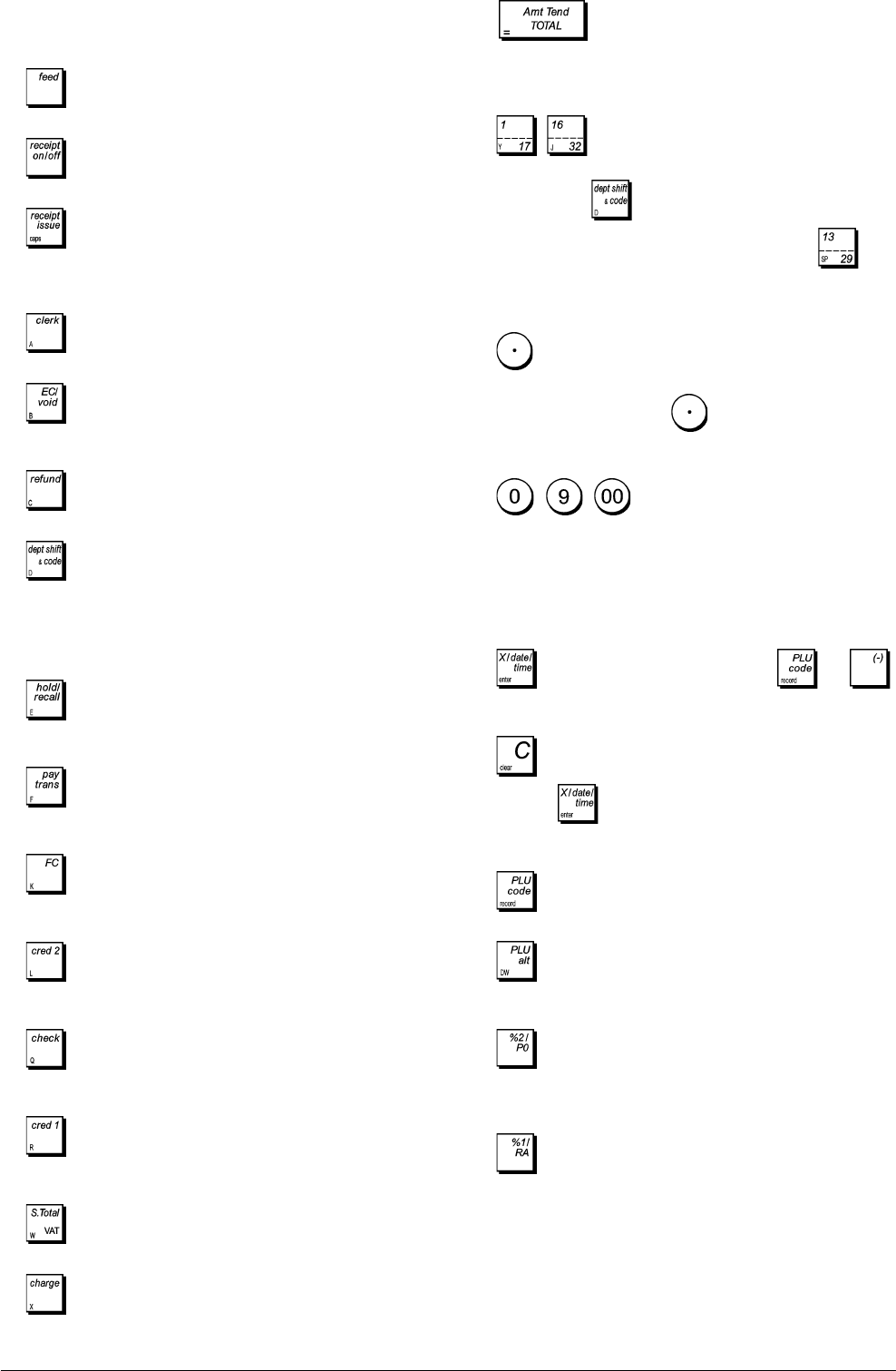
2
Keypad Functions
With reference to figure 5:
1.
- Advances the receipt or journal paper one line
feed; advances the paper continuously when held down.
2.
- Toggles the cash register between printing and
not printing the sales receipt in the REG or MGR mode.
3.
- If the cash register is set accordingly, prints one
or more copies of the last sales receipt. When pressed
during caption programming, toggles between caps on/
off.
4.
- Confirms an entered clerk number. Used during
caption programming.
5.
- Deletes the last item entered, and corrects a
particular entry after it is processed and printed, or full
entries after a subtotal.
Used during caption programming.
6. - Subtracts an item that is returned for refund. Used
during caption programming.
7. - Allows price entries for departments 17-32 and
33-99. For departments 17-32, press this key before
entering the applicable department keys. F
or departments
33-99, press this key, manually enter the department
number using the numeric keypad, then press this key
again. Used during caption programming.
8 - Holds and then recalls a sales transaction so that
a second transaction can be performed in the meantime.
Used during caption programming.
9.
- Transfers payment from one form of payment to
another after the finalization of a sales transaction. Used
during caption programming.
10.
- Automatically calculates and displays the value in
foreign currency of the subtotal of a sale or of a particular
amount registered.
Used during caption programming.
11. - Registers sales that are put on a credit card that
is alternative to Credit Card 1 or the one used for Charge
tenders.
Used during caption programming.
12. - Registers sales paid by check. Confirms the clerk
three-digit code entered and is used during caption
programming to also confirm the entries made.
13. - Registers sales that are put on a credit card that
is alternative to Credit Card 2 or the one used for Charge
tenders.
Used during caption programming.
14. - Subtotals a sale, and used for the programming of
VAT rates. Used during caption programming.
15.
- Registers sales that are charged. Used during
caption programming.
16. - Totals exact cash transactions, computes
change and totals transactions that are split tendered
with check or credit card and cash together. Used to exit
a programming session.
17.
- - Departments 1 through 16, to enter single
or multiple item sales to a particular department. When
pressed after
, registers to Departments 17 through
32. Used during caption programming; the
key
confirms the entry of the selected character when the
same key is repeated to enter same character again, and
adds a space between characters.
18.
- Enters a decimal point for defining product
quantities with decimals during sales transactions. During
caption programming,
is used as the typical
backspace function for cancelling the last character
entered.
19.
- / - Input amounts, indicate how many
times a particular item repeats, add and subtract
percentage rates and input department code numbers.
Used to input the characters indicated on the related key
and indicated in the Character Table when defining clerk
names, receipt header/footer, department names,
department group names, PLU product names, currency
identifiers and credit card captions.
20.
- Multiplies [DEPARTMENT], or
entries, toggles between displaying the current date and
the current time.
21.
- Clears an entry made from the numeric keypad
or with before finalizing a transaction with a
Department or function key. Also used to clear error
conditions.
22. - Registers a preset price of an individual item to
the appropriate department.
23.
- Temporarily overwrites a price that was assigned
to a PLU number. During caption programming, pressed
before a character sets the character as double width.
24.
- As the %2 key, when programmed accordingly
subtracts a percentage from an item or sales total. As the
PO key, registers any money taken out of the cash
drawer that is not part of a sale.
25.
- As the %1 key, when programmed accordingly
subtracts a percentage from an item or sales total. As the
RA key, registers any money received on account that is
not part of a sale; for example, the start-up money put in
the drawer at the start of each business day can be
registered as an RA.


















